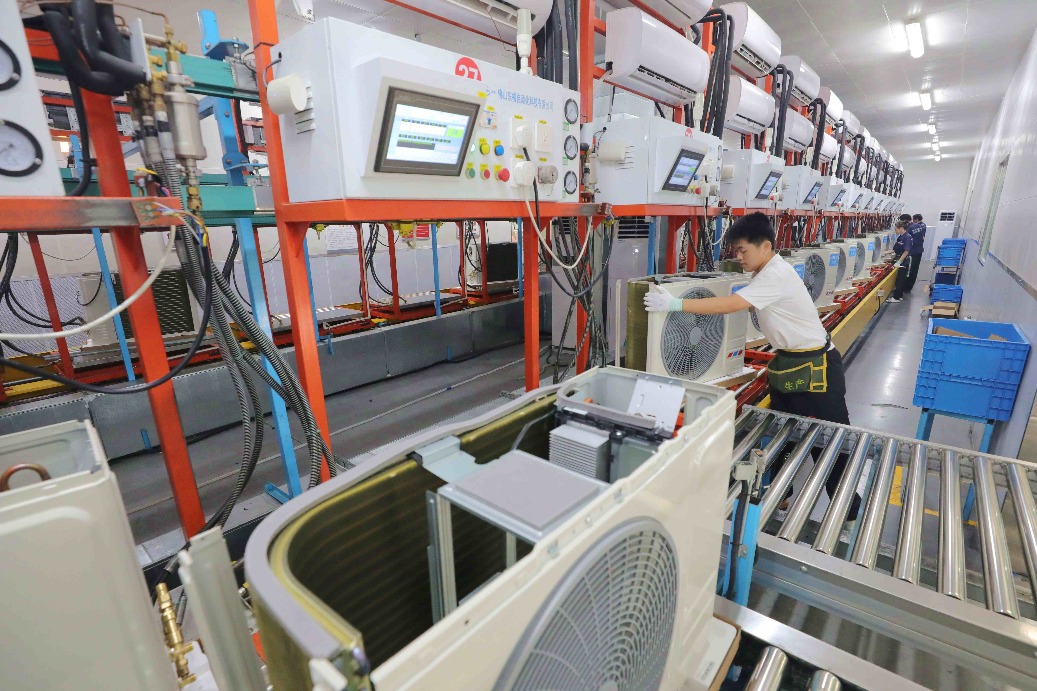Higher infrastructure investment needed to boost economic growth


China has seen a strong rebound in GDP growth since the second quarter of last year but the rebound is weakening to some extent. At the same time, the country may tighten its monetary policy this year.
As consumption is still not enough to become the main driver of economic growth, infrastructure investment should continue to increase, and it is inappropriate for China to exit from expansionary fiscal policy prematurely.
A fairly strong rebound has occurred in China's economy after a dramatic decline in growth caused by the COVID-19 pandemic. Its GDP growth rate was 2.3 percent in 2020, far exceeding the numbers of many other countries.
Despite the satisfactory economic performance, we still saw signs of weakening of economic rebound at the end of last year. For instance, investments in real estate, infrastructure and the manufacturing sector all weakened in the last few months of 2020.Consumption growth also slowed down in December from a month earlier.
The market expects China's GDP to achieve double-digit growth year-on-year in the first quarter due to the low base effect last year. But this does not necessarily mean that the country has given full play to its growth potential. We expect to see a gradual slowdown in growth during the last three quarters of this year because of economic enhancement since the second quarter of 2020.
China set an economic growth target of above 6 percent for this year. Although we do not know the upper potential limit, we can be sure that the figure of 6 percent is notably below market expectations.
In fact, if real GDP growth for the full year 2021 was 6 percent over the previous year, it would mean China's economic growth has not yet returned to the pre-pandemic level.
Compared with last year, the underlying tone of China's fiscal policy indicates a return to normal this year, and its monetary policy is also more prudent. The government does not want to use a strong expansionary fiscal policy. The reasons might be these:
First, the government is concerned that expansionary fiscal and monetary policies will amplify vulnerabilities in the financial environment.
Second, the government hopes to leave policy space for future risks.
Official data showed that China's fiscal policy will become tighter to some extent this year, compared to 2020. While the general public budget expenditure declines, the general public budget income will increase over the same period.
Therefore, the country's budget deficit in 2021 will be less than the figure last year. As the central government has already set an economic growth target of above 6 percent, the budget deficit-to-GDP ratio can be expected to fall this year.
Besides, China's monetary policy is not very loose. The country tends to tighten its repurchase rates, such as the seven-day repurchase rate for depositary institutions, although the extent of tightening is not obvious.
Given the signals issued by the government so far, China will tighten its macroeconomic policies to some extent this year.
I would like to share some of my views on the current economic policies.
First, the lower limit of GDP growth target of 6 percent set by the government for this year is insufficient to mobilize economic resources. Assuming that China's potential economic growth rate is 6 percent year-on-year, even if the country achieves the target of 6 percent growth, its economic growth rate is still below potential economic growth rate, if we take last year's low base effects into consideration.
Second, it is inappropriate for China to exit from the expansionary fiscal policy prematurely. Some economists worry that expansionary fiscal and monetary policies may lead to undesirable consequences, so they advocate an exit from expansionary policies as soon as possible.
In my opinion, however, even if we do not take the downward pressure of China's pre-pandemic economic growth into consideration, it will still be difficult for the country to overcome the inertia of an economic downturn, if it exits from expansionary policies prematurely, as the Chinese economy is in the stage of growth recovery.
Third, the primary task of fiscal and monetary policies is to boost economic growth, rather than stabilizing leverage ratio, especially the leverage ratio of the public sector.
Fourth, there is no need for China to worry about inflation. In fact, the core inflation rate is very low domestically at present. The rate was less than 1 percent in February. Besides, the producer price index remained negative for most of the time in the past 10 years.
Fifth, China can take other measures to deal with asset bubbles. The government should not stop the adoption of an expansionary monetary policy due to concerns about losing control over asset prices. That is because the government can contain asset bubbles through many other means.
Sixth, an inadequate economic growth rate will increase, rather than reduce, vulnerabilities of the financial environment. China has had that experience at the end of the 1990s and the beginning of this century.
Seventh, employment issues are still worthy of serious attention. Jobs should be created based on economic growth, rather than the cost of lowering labor productivity.
Eighth, under the current circumstances, it is difficult for consumption to become the main driver of economic growth. Although the government hopes to boost consumption, the income growth of residents is still insufficient to eliminate their anxiety of uncertainty about their future income prospects, as the outlook for the Chinese economy remains uncertain.
In this situation, what is on top of their mind is to replenish or even increase savings. Consumption cannot become the main driving force of economic growth.
Therefore, in order to spur economic growth, the government needs to support infrastructure investment via expansionary fiscal and monetary policies. However, the growth rate of China's infrastructure investment was about 1 percent last year, which was too low.
During the period of countercyclical adjustments, the growth rate of infrastructure investment being higher than that of GDP is the universal law.
Ninth, it is not enough to simply rely on macroeconomic policies to drive growth. Multiple reform measures should be undertaken at the same time to ensure that all economic entities, especially the local governments, have enough motivation to respond positively to expansionary economic policies.
Finally, spurring high-speed economic growth in 2021 is not only in the interest of China but also in the interest of other countries. China should achieve a more balanced international balance of payments. But only if the country maintains reasonable GDP growth will it increase imports to improve its international trade balance.
The writer is an adviser to the China Finance 40 Forum or CF40, a Chinese think tank in the field of finance and macroeconomics, and an academician at the Chinese Academy of Social Sciences.
The views don't necessarily reflect those of China Daily.





































